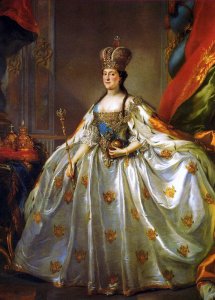Catherine II or Catherine the Great was from Germany but moved to Russia after she married Peter III. Although love was an important part of Catherine’s life, it did not overshadow her everlasting learning process and political interests. She was considered a sharp- witted and educated young women, she read widely, spoke many languages, and was very greedy. When Empress Elizabeth died , her nephew Peter was proclaimed Emperor Peter III, and Catherine became Empress. Friends warned her that she might not enjoy her status for long since Peter was planning to divorce her and she was advised to flee. She decided to ignore the warning, and the wisdom of her decision was soon demonstrated. A few months after taking the throne, Peter built up much hostility among government, military, nobles and church leaders. So, a group of them began plotting a coup to remove him. They wanted to place his 7-year-old son, Paul, on the throne, and name Catherine as regent until the boy should come of age. However they underestimated Catherine’s ambition to gain the throne. After she attained the throne she had Peter arrested and forced him to sign an act of abdication. When he sought permission to leave the country, she refused it, intending to hold him prisoner for life. He had only a few days to live, though, as shortly after his arrest he was killed in a fight with his captors.
The scene in the painting takes place during the ceremony of Catherine the Great. It can be inferred that she was incredibly rich because of the vast amount of jewels on her crown and dress, how big her dress is, and how much gold is on her dress, coronation staff and ball. There is also an immense amount of detail in the painting; so much in fact that you can see almost every little jewel on her crowns. The gown is made of silver silk, with lace sleeves and a lace bertha around the neckline. Embroidered golden eagles serve as the repeated pattern throughout with ermine trim at the hem. The blue sash, worn from the right shoulder to the waist, represents the Order of St. Andrew the First Called and is principally bestowed upon the royal family. Today her gown is kept at the Kremlin Armoury.
